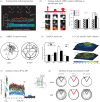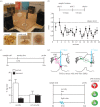The synaptic plasticity and memory hypothesis: encoding, storage and persistence
- PMID: 24298167
- PMCID: PMC3843897
- DOI: 10.1098/rstb.2013.0288
The synaptic plasticity and memory hypothesis: encoding, storage and persistence
Abstract
The synaptic plasticity and memory hypothesis asserts that activity-dependent synaptic plasticity is induced at appropriate synapses during memory formation and is both necessary and sufficient for the encoding and trace storage of the type of memory mediated by the brain area in which it is observed. Criteria for establishing the necessity and sufficiency of such plasticity in mediating trace storage have been identified and are here reviewed in relation to new work using some of the diverse techniques of contemporary neuroscience. Evidence derived using optical imaging, molecular-genetic and optogenetic techniques in conjunction with appropriate behavioural analyses continues to offer support for the idea that changing the strength of connections between neurons is one of the major mechanisms by which engrams are stored in the brain.
Keywords: dopamine; engram; initial consolidation; long-term potentiation; memory; synaptic plasticity.
Figures



References
-
- Hebb DO. 1949. The organization of behaviour. New York, NY: Wiley.
-
- Konorski J. 1948. Conditioned reflexes and neuron organisation. Cambridge, UK: Cambridge University Press.
-
- Kandel ER. 1978. A cell-biological approach to learning. Bethesda, MD: Society for Neuroscience.
Publication types
MeSH terms
Substances
Grants and funding
LinkOut - more resources
Full Text Sources
Other Literature Sources
Medical
